Abstract
1. Effects of three compounds which are used as calmodulin inhibitors (trifluoperazine, W-7 and calmidazolium) on Ca2+ channels were investigated in smooth muscle from rat vas deferens. 2. All three calmodulin inhibitors relaxed the smooth muscle precontracted by a high concentration of KCl (63.7 mM). The order of potency for the relaxation was trifluoperazine > W-7 > calmidazolium. 3. In binding studies using a microsomal fraction of vas deferens, all these calmodulin inhibitors displaced specific [3H]-nimodipine binding. Trifluoperazine and W-7 inhibited the binding at concentrations that relaxed the smooth muscle whereas calmidazolium inhibited at concentrations much lower than those necessary for muscle relaxation. 4. Ba2+ current flowing through voltage-gated Ca2+ channels was measured under whole-cell voltage-clamp conditions in isolated smooth muscle cells. The Ba2+ current was suppressed by the three calmodulin inhibitors in the concentration-range where inhibition of [3H]-nimodipine binding was observed. Neither voltage-dependence nor the inactivation time course of Ba2+ current were affected by these compounds. 5. The results suggest that the calmodulin inhibitors directly block Ca2+ channels in the smooth muscle cells. The channel inhibition by trifluoperazine and W-7, but perhaps not that by calmidazolium, may be responsible for the muscle relaxation observed with these compounds.
Full text
PDF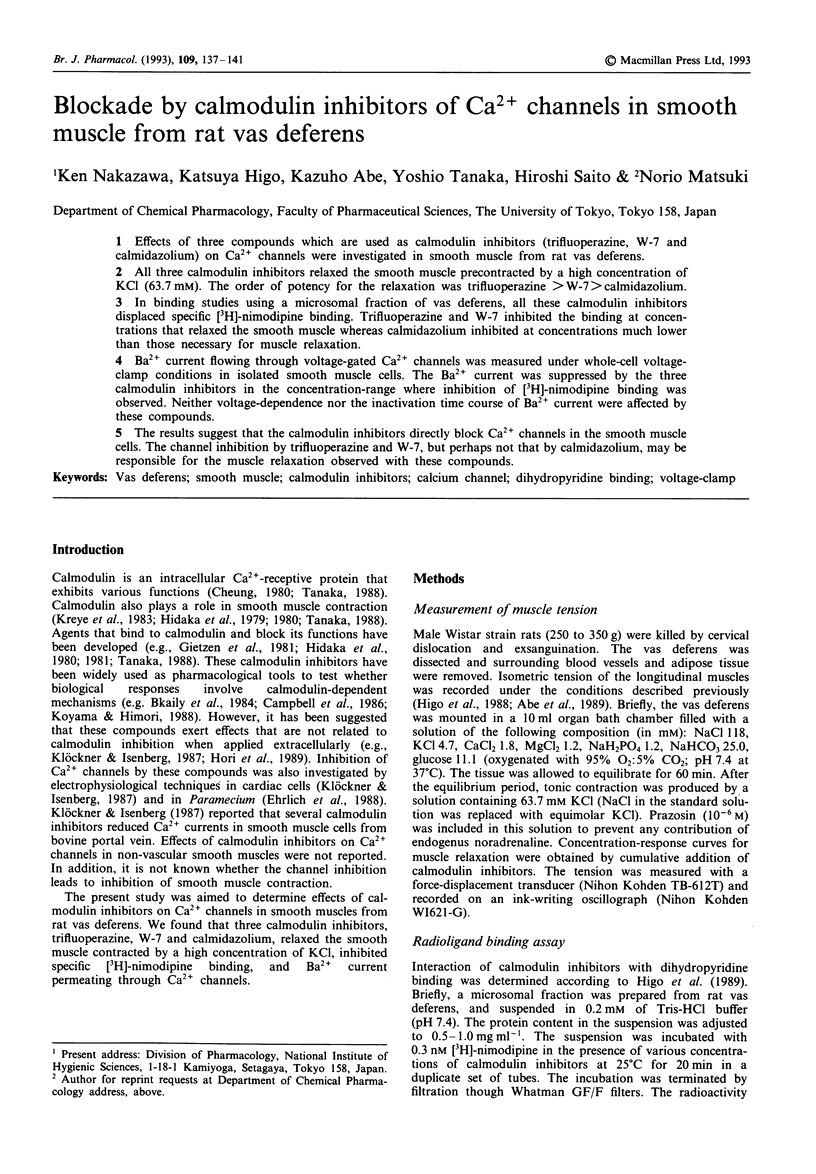
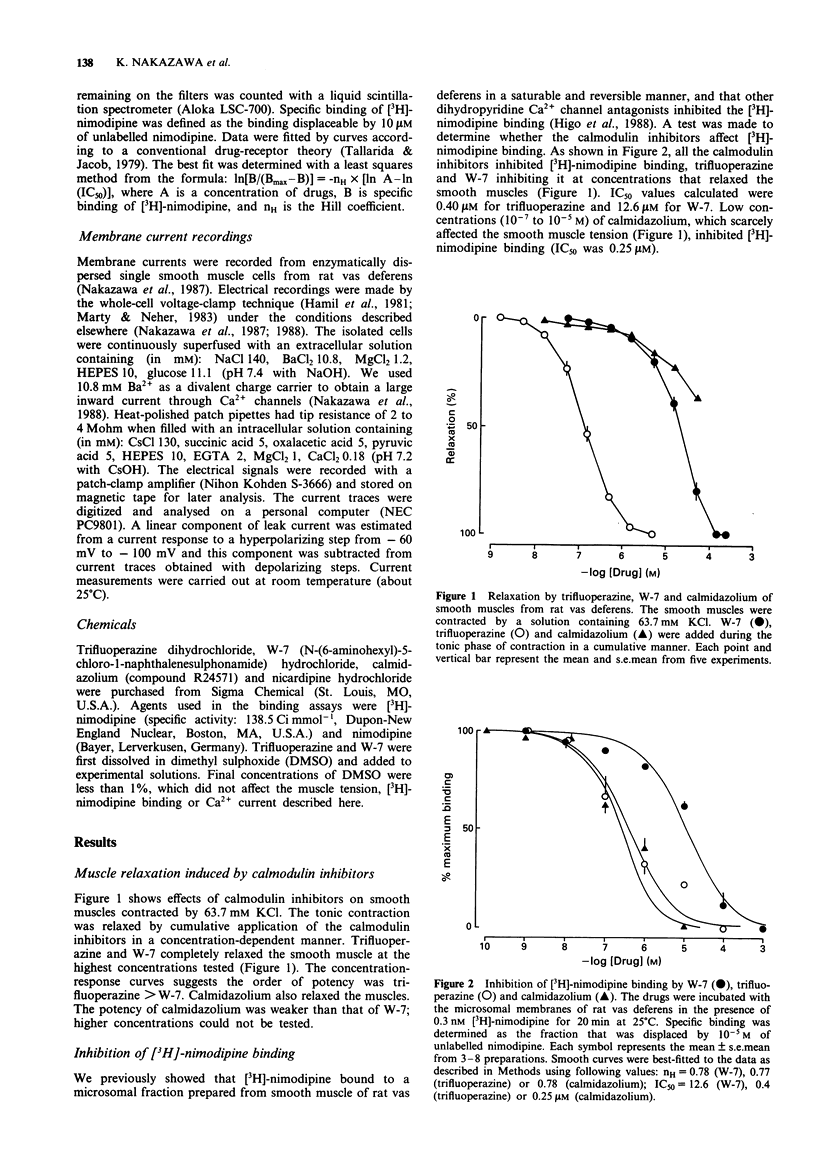
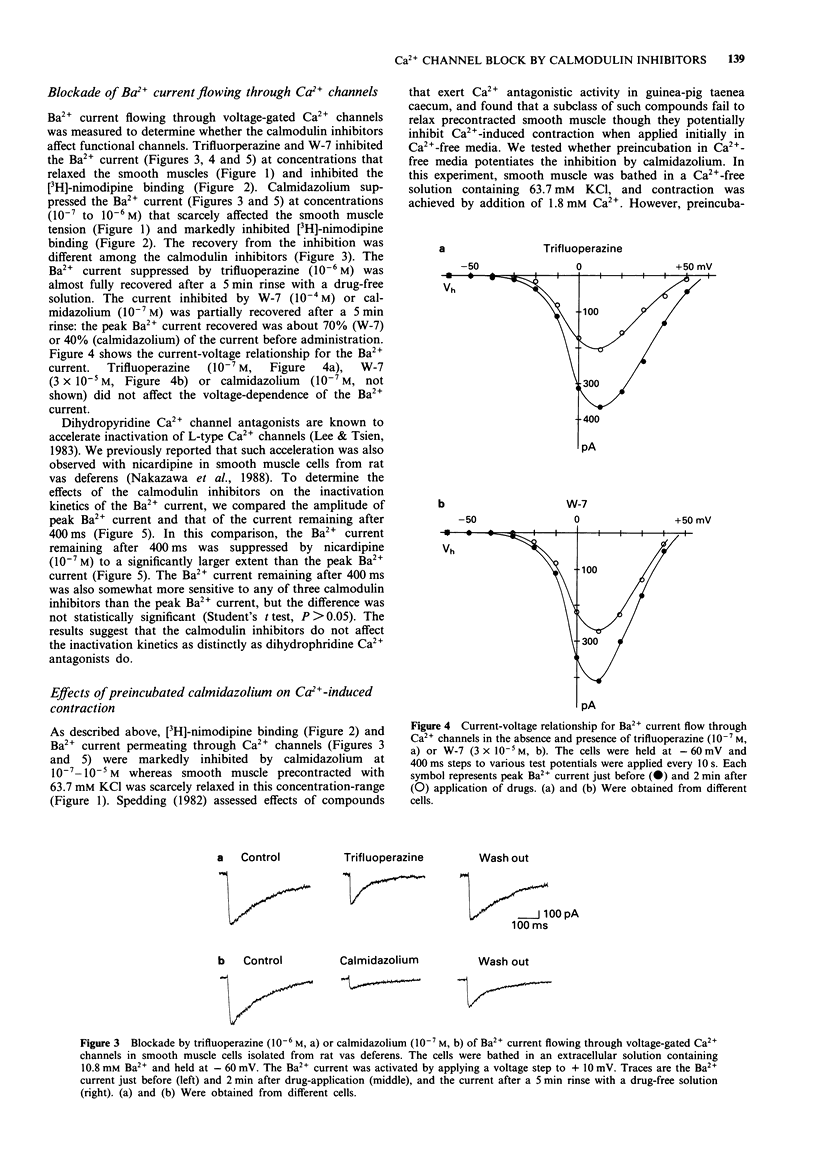
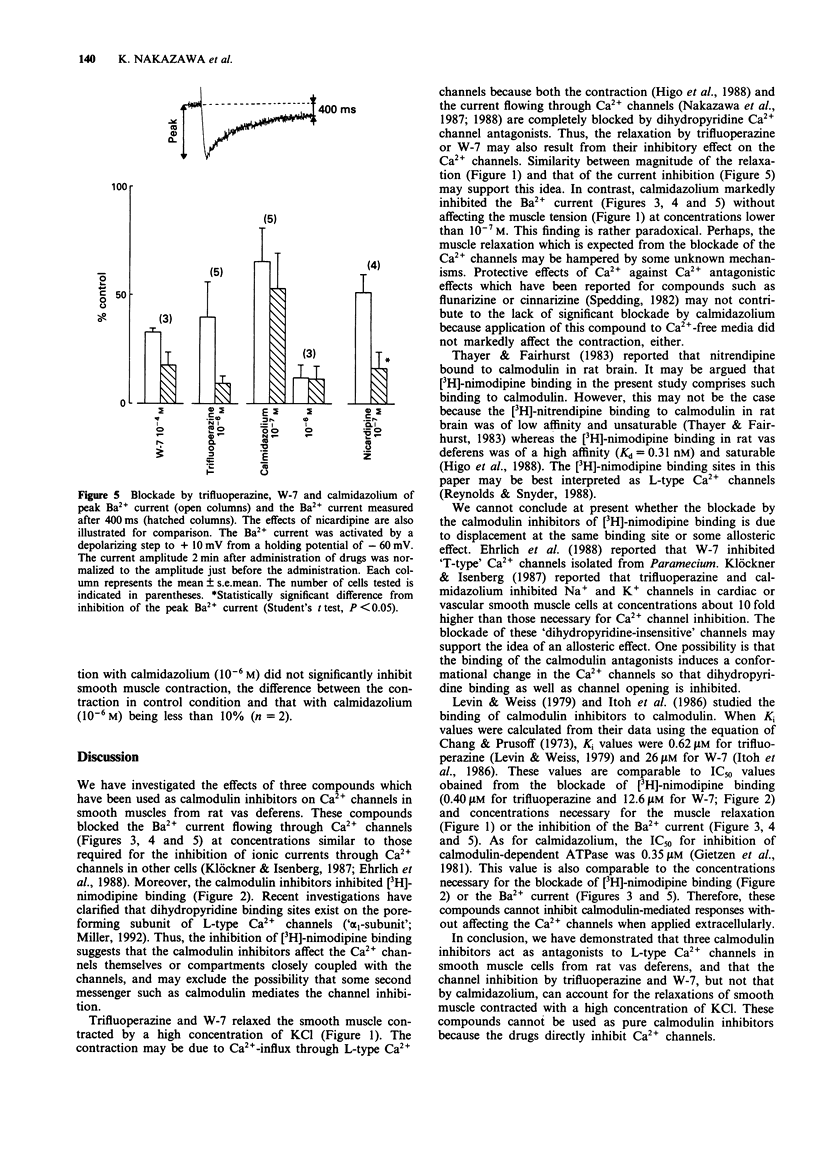
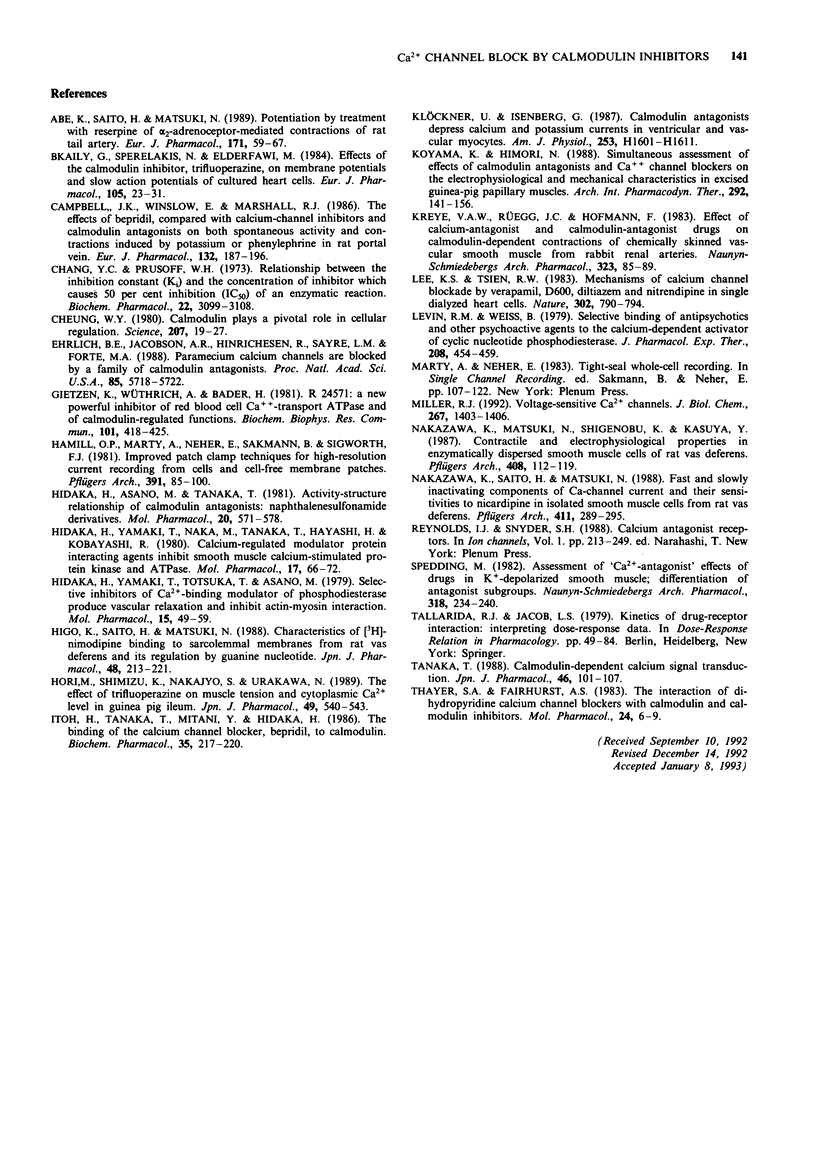
Selected References
These references are in PubMed. This may not be the complete list of references from this article.
- Abe K., Saito H., Matsuki N. Potentiation by treatment with reserpine of alpha 2-adrenoceptor-mediated contractions of rat tail artery. Eur J Pharmacol. 1989 Nov 14;171(1):59–67. doi: 10.1016/0014-2999(89)90429-9. [DOI] [PubMed] [Google Scholar]
- Bkaily G., Sperelakis N., Eldefrawi M. Effects of the calmodulin inhibitor, trifluoperazine, on membrane potentials and slow action potentials of cultured heart cells. Eur J Pharmacol. 1984 Oct 1;105(1-2):23–31. doi: 10.1016/0014-2999(84)90645-9. [DOI] [PubMed] [Google Scholar]
- Campbell J. K., Winslow E., Marshall R. J. The effects of bepridil, compared with calcium-channel inhibitors and calmodulin antagonists on both spontaneous activity and contractions induced by potassium or phenylephrine in rat portal vein. Eur J Pharmacol. 1986 Dec 16;132(2-3):187–196. doi: 10.1016/0014-2999(86)90604-7. [DOI] [PubMed] [Google Scholar]
- Cheng Y., Prusoff W. H. Relationship between the inhibition constant (K1) and the concentration of inhibitor which causes 50 per cent inhibition (I50) of an enzymatic reaction. Biochem Pharmacol. 1973 Dec 1;22(23):3099–3108. doi: 10.1016/0006-2952(73)90196-2. [DOI] [PubMed] [Google Scholar]
- Cheung W. Y. Calmodulin plays a pivotal role in cellular regulation. Science. 1980 Jan 4;207(4426):19–27. doi: 10.1126/science.6243188. [DOI] [PubMed] [Google Scholar]
- Ehrlich B. E., Jacobson A. R., Hinrichsen R., Sayre L. M., Forte M. A. Paramecium calcium channels are blocked by a family of calmodulin antagonists. Proc Natl Acad Sci U S A. 1988 Aug;85(15):5718–5722. doi: 10.1073/pnas.85.15.5718. [DOI] [PMC free article] [PubMed] [Google Scholar]
- Gietzen K., Wüthrich A., Bader H. R 24571: a new powerful inhibitor of red blood cell Ca++-transport ATPase and of calmodulin-regulated functions. Biochem Biophys Res Commun. 1981 Jul 30;101(2):418–425. doi: 10.1016/0006-291x(81)91276-6. [DOI] [PubMed] [Google Scholar]
- Hamill O. P., Marty A., Neher E., Sakmann B., Sigworth F. J. Improved patch-clamp techniques for high-resolution current recording from cells and cell-free membrane patches. Pflugers Arch. 1981 Aug;391(2):85–100. doi: 10.1007/BF00656997. [DOI] [PubMed] [Google Scholar]
- Hidaka H., Asano M., Tanaka T. Activity-structure relationship of calmodulin antagonists, Naphthalenesulfonamide derivatives. Mol Pharmacol. 1981 Nov;20(3):571–578. [PubMed] [Google Scholar]
- Hidaka H., Yamaki T., Naka M., Tanaka T., Hayashi H., Kobayashi R. Calcium-regulated modulator protein interacting agents inhibit smooth muscle calcium-stimulated protein kinase and ATPase. Mol Pharmacol. 1980 Jan;17(1):66–72. [PubMed] [Google Scholar]
- Hidaka H., Yamaki T., Totsuka T., Asano M. Selective inhibitors of Ca2+-binding modulator of phosphodiesterase produce vascular relaxation and inhibit actin-myosin interaction. Mol Pharmacol. 1979 Jan;15(1):49–59. [PubMed] [Google Scholar]
- Higo K., Saito H., Matsuki N. Characteristics of [3H]nimodipine binding to sarcolemmal membranes from rat vas deferens and its regulation by guanine nucleotide. Jpn J Pharmacol. 1988 Oct;48(2):213–221. doi: 10.1254/jjp.48.213. [DOI] [PubMed] [Google Scholar]
- Hori M., Shimizu K., Nakajyo S., Urakawa N. The effect of trifluoperazine on muscle tension and cytoplasmic Ca2+ level in guinea pig ileum. Jpn J Pharmacol. 1989 Apr;49(4):540–543. doi: 10.1254/jjp.49.540. [DOI] [PubMed] [Google Scholar]
- Itoh H., Tanaka T., Mitani Y., Hidaka H. The binding of the calcium channel blocker, bepridil, to calmodulin. Biochem Pharmacol. 1986 Jan 15;35(2):217–220. doi: 10.1016/0006-2952(86)90516-2. [DOI] [PubMed] [Google Scholar]
- Klöckner U., Isenberg G. Calmodulin antagonists depress calcium and potassium currents in ventricular and vascular myocytes. Am J Physiol. 1987 Dec;253(6 Pt 2):H1601–H1611. doi: 10.1152/ajpheart.1987.253.6.H1601. [DOI] [PubMed] [Google Scholar]
- Koyama K., Himori N. Simultaneous assessment of effects of calmodulin antagonists and Ca++ channel blockers on the electrophysiological and mechanical characteristics in excised guinea-pig papillary muscles. Arch Int Pharmacodyn Ther. 1988 Mar-Apr;292:141–156. [PubMed] [Google Scholar]
- Kreye V. A., Rüegg J. C., Hofmann F. Effect of calcium-antagonist and calmodulin-antagonist drugs on calmodulin-dependent contractions of chemically skinned vascular smooth muscle from rabbit renal arteries. Naunyn Schmiedebergs Arch Pharmacol. 1983 Jun;323(2):85–89. doi: 10.1007/BF00634253. [DOI] [PubMed] [Google Scholar]
- Lee K. S., Tsien R. W. Mechanism of calcium channel blockade by verapamil, D600, diltiazem and nitrendipine in single dialysed heart cells. Nature. 1983 Apr 28;302(5911):790–794. doi: 10.1038/302790a0. [DOI] [PubMed] [Google Scholar]
- Levin R. M., Weiss B. Selective binding of antipsychotics and other psychoactive agents to the calcium-dependent activator of cyclic nucleotide phosphodiesterase. J Pharmacol Exp Ther. 1979 Mar;208(3):454–459. [PubMed] [Google Scholar]
- Miller R. J. Voltage-sensitive Ca2+ channels. J Biol Chem. 1992 Jan 25;267(3):1403–1406. [PubMed] [Google Scholar]
- Nakazawa K., Matsuki N., Shigenobu K., Kasuya Y. Contractile response and electrophysiological properties in enzymatically dispersed smooth muscle cells of rat vas deferens. Pflugers Arch. 1987 Feb;408(2):112–119. doi: 10.1007/BF00581338. [DOI] [PubMed] [Google Scholar]
- Nakazawa K., Saito H., Matsuki N. Fast and slowly inactivating components of Ca-channel current and their sensitivities to nicardipine in isolated smooth muscle cells from rat vas deferens. Pflugers Arch. 1988 Mar;411(3):289–295. doi: 10.1007/BF00585117. [DOI] [PubMed] [Google Scholar]
- Reynolds I. J., Snyder S. H. Calcium antagonist receptors. Ion Channels. 1988;1:213–249. doi: 10.1007/978-1-4615-7302-9_6. [DOI] [PubMed] [Google Scholar]
- Spedding M. Assessment of "Ca2+ -antagonist" effects of drugs in K+ -depolarized smooth muscle. Differentiation of antagonist subgroups. Naunyn Schmiedebergs Arch Pharmacol. 1982 Feb;318(3):234–240. doi: 10.1007/BF00500485. [DOI] [PubMed] [Google Scholar]
- Tanaka T. Calmodulin-dependent calcium signal transduction. Jpn J Pharmacol. 1988 Feb;46(2):101–107. doi: 10.1254/jjp.46.101. [DOI] [PubMed] [Google Scholar]
- Thayer S. A., Fairhurst A. S. The interaction of dihydropyridine calcium channel blockers with calmodulin and calmodulin inhibitors. Mol Pharmacol. 1983 Jul;24(1):6–9. [PubMed] [Google Scholar]


